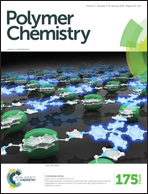UV-Vis/FT-NIR in situ monitoring of visible-light induced polymerization of PEGDA hydrogels initiated by eosin/triethanolamine/O2†
Abstract
In conjunction with a tertiary amine coinitiator, eosin, a photoreducible dye, has been shown to successfully circumvent oxygen inhibition in radical photopolymerization reactions. However, the role of O2 in the initiation and polymerization processes remains inconclusive. Here, we employ a UV-Vis/FT-NIR analytical tool for real-time, simultaneous monitoring of chromophore and monomer reactive group concentrations to investigate the eosin-activated photopolymerization of PEGDA-based hydrogels under ambient conditions. First, we address the challenges associated with spectroscopic monitoring of the polymerization of hydrogels using UV-Vis and FT-NIR, proposing metrics for quantifying the extent of signal loss from reflection and scattering, and showing their relation to microgelation and network formation. Second, having established a method for extracting kinetic information by eliminating the effects of changing refractive index and scattering, the coupled UV-Vis/FT-NIR system is applied to the study of eosin-activated photopolymerization of PEGDA in the presence of O2. Analysis of the inhibition time, rate of polymerization, and rate of eosin consumption under ambient and purged conditions indicates that regeneration of eosin in the presence of oxygen and consumption of oxygen occur via a nonchain process. This suggests that the uniquely high O2 resilience is due to alternative processes such as energy transfer from photo-activated eosin to oxygen. Uncovering the intricacies of the role of O2 in eosin-mediated initiation aids the design of O2 resistant free radical polymerization systems relevant to photonics, optoelectronics, biomaterials, and biosensing.



 Please wait while we load your content...
Please wait while we load your content...